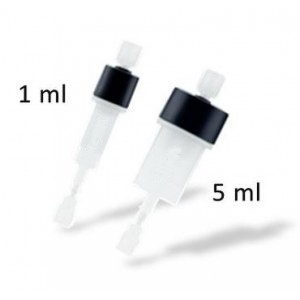Ion exchange (IEX) FPLC columns

Ion exchange (IEX) FPLC columns for negatively and positively charged proteins
Ion exchange chromatography (IEX) resins are commonly used to separate molecules, such as large proteins, small nucleotides, and amino acids, depending on their charge. The functional groups in the IEX resins have charges that bind the molecules with opposite charges. The release of the molecules bound to the resin is carried out by charge displacement, via the application of an increasing concentration of a molecule of the same charge.
Depending on the size of the beads, the pore size, the functional groups and the mechanical strength of the individual base matrices, our IEX resins can be used to capture bulk products or impurities from large volumes , as an intermediate step or as a final step for high resolution purifications.
There are different types of exchangers:
- Strong exchangers: Q, S, SP. These exchangers make it possible to work on a wide pH range.
- Weak exchangers: DEAE, ANX, CM. It is advisable to use these exchangers if the selectivity of the strong ion exchangers is not satisfactory. However, the ion exchange capacity of a weak ion exchanger varies with pH.
- Multimodal ligands (MMC) provide ionic interaction, hydrogen bonding and hydrophobic interaction. The MMC behaves like a weak cation exchanger, but allows a high conductivity bond.
HiFliQ columns pre-packed and ready to use with Quaternary ammonium group (Q) or sulphonic acid propyl linked (S) coupled Agarose resinfor rapid Ion Exchange (IEX) purification of negatively or positively charged proteins under native conditions.

Available in 1 ml and 5 ml HiFliQ column sizes with high ligand density and high binding capacity. Compatible with all common chromatography HPLC and FPLC instruments (including ÄKTA FPLC's), and low pressure pumps and syringes using an appropriate adaptor.
Specification :
- Column volume : 1 ml or 5 ml
- Resin : Quaterny ammonium (Q) or sulphonic acid propyl linked (S) agarose
- Typical binding capacity : 50-70 mg for 1 ml ; 250-300 mg for 5 ml
- Base matrix : 6%cross-linked agarose
- Mean bead size : 90 µm
- Recommended flow rate : 1 ml/minfor 1ml ; 1-6 ml/minfor 5 ml
- Max. operating pressure : 0.5 MPa (72 psi)
- External dimensions : 15 mm D. x 80 mm H. for 1 ml ; 23 mm D. x 80 mm H. for 5 ml
- Column construction : Polypropylene
- Inlet Port : 10-32 (1/16") Female
- Outlet Port : 10-32 (1/16") Male
- Storage (2-30°C) : 20%ethanol or 20%ethanol + 0.2 M acétate de sodium

